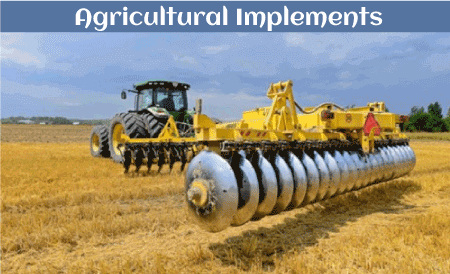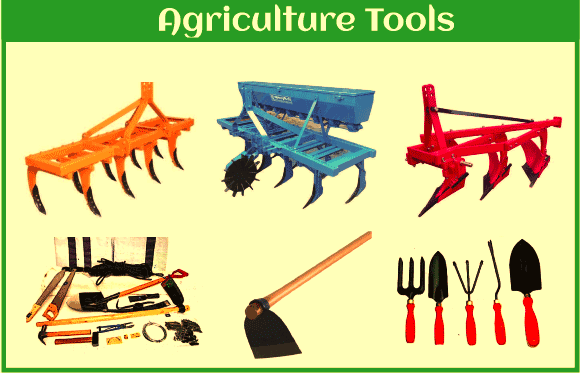Agricultural Implements
Agriculture is a time-consuming operation that cannot be completed by hand. As a result, agricultural procedures must be carried out with the aid of equipment and machines. These agricultural tools that are used in the cultivation of plants are called agricultural implements.

What are Agricultural Implements?
Agricultural implements are the tools needed to carry out farming operations. In today's farming activities, a variety of agricultural equipment are employed. In general, there are five different sorts of implements.
Agriculture implements are equipment that are used in agricultural activities to decrease human labor and improve field crop yield. Harvesters, drag, disc harrows, cultivators, seed drills, harrows, spades, pickage, ploughs, and other agricultural instruments are among the most common. In nations like India, where agriculture and farming are the predominant vocations, these equipment are in high demand.
Before Industrialization
Nomadism was a way of life for humanity in the past. He ate raw fruits, vegetables, and meat as he went from place to place. However, after 10,000 B.C., he began farming and using his own tools. Men began to inhabit the land, produce their crops, and feed themselves. Agriculture is the activity of cultivating and maintaining the same type of plants on a piece of land, and the plant is known as a crop. Irrigation, weed eradication, and proper harvesting are all part of agricultural crop upkeep. He used to do all of these things using hand tools or by doing hard labor. These tools included an axe, sickle, hoe, and other items that they built themselves out of stone and wood.
After Industrialization
Humans have been able to create newer and larger machines as a result of fast industrialization and technical developments. These devices eliminate the need for physical labor and make agricultural jobs easier. These machines are extremely important in the modern and scientific world of agriculture. Tractors and advanced harvesters revolutionized the way people worked in the fields. Using these technological advantages, farmers may now labor more professionally. With these devices, working in the fields is no longer a strenuous and exhausting activity.
Types of agricultural implements
Agricultural tools come in a variety of shapes and sizes, and they are utilized at various stages of crop production and management. From field preparation through harvesting and storing the produce, humans have devised specialized equipment for each task. The following are some of these tools:
- Tools for preparing the soil: It is the first and most important phase in the crop production process. This process is crucial because it helps crop roots to penetrate deeper into the soil and absorb more water and nutrients. It also aids in the field's aeration and mineral enrichment. Ploughing and tilling is the process of loosening and turning the soil. This is accomplished using simple tools such as plough, hoe, and cultivators. A plough has been in use since antiquity; it was built of wood and was pulled by a horse or bull. A hoe is a manual implement that is used to loosen soil and remove weeds. A cultivator is contemporary equipment that reduces physical labor and saves time.
- Tools for sowing: A funnel-shaped instrument that contains the seeds is used in the traditional method of sowing. These seeds next pass through the funnel's pipe end, which ensures that they are sufficiently separated and that clustered sowing does not occur. The seeds are deposited in the soil via the ends of the pipes. Nowadays, however, seeding is done with a seed drill. A driller is advantageous because it sows the seeds at the proper depth and spacing.
- Irrigation machinery: Irrigation equipment consists of a pump that is used to extract water from the ground. A sprinkler system with perpendicular pipes and a revolving nozzle, as well as a drip irrigation piping system, are examples of modern irrigation instruments. These two contemporary methods are critical in conserving water while still giving adequate water to the plants.
- Harvesting machinery: Harvesting is the process of cutting a crop when it is fully grown. Previously, it was done using a sickle, a sharp and curved metal and wood implement. Harvesters are now utilized for this purpose. A combine is a machine that combines the functions of a thresher and a harvester. It may thresh after the crops have been harvested from the field.
- Planting Machines: After the soil has been cultivated, they are used to plant seeds and seedlings across a vast area. Broadcast seeders, precision drills, air seeders, seed drills, transplanting equipment, and other tools are used to do this.
- Harvesting Implements: Harvesting ripe crops is done with these implements. Trailers, diggers, and pickers are some examples.
- Other Agricultural Equipment: These are employed in the later stages of agriculture, including hay production, loading, and shredding.
Agricultural Tools
Agricultural implements such as the sickle, plough, hoe, drills, and other implements are used in agricultural operations to increase productivity and efficiency. Farmers employ a wide range of agricultural instruments to cultivate their crops.

The many sorts of agricultural implements used in farming are as follows:
- Plough: It is generally made of wood and dragged by two bulls. It has been used for tiling, stirring the soil, and applying fertilizers since ancient times. It is made up of a plough shaft, which is a long wooden log. It has a ploughshare, which is a powerful triangular iron strip. The other end is attached to a beam, which is subsequently fastened around the neck of the bull. However, iron ploughs have replaced wooden ploughs, and it is now drawn by tractors.
- Hoe: Hoe is being used for agriculture since prehistoric times. It is made out of a long wooden pole that is pushed by the animals. It is used to loosen the soil and remove weeds and is dragged by the animals. It features a blade made of a robust, wide, bent plate of iron.
- Cultivator: A cultivator is a plough that is linked to a tractor. This cuts down on labor and saves time. It agitates the soil around the growing crop to encourage development and weed control.
- Seed Drill: This is used for seed planting. Tractors are used to do this. It ensures that the seeds are placed at the same distances and depths and that they are completely covered with dirt. This ensures that plants get enough sunshine, nutrients, and water from the soil. This preserves time and labor while also preventing birds and other animals from eating the seeds.
- Traditional Tool: A funnel-shaped instrument is used to plant seeds traditionally. Seeds have been poured into the funnel. The seeds are fed through two or three sharp-end pipes. These ends are inserted into the earth, where the seeds are planted. Farmers' traditional agricultural instruments include the sickle, spade, and axe. It is a labor-intensive and time-consuming agricultural method.
Benefits of Agricultural Implements
The following are some of the advantages of agricultural implements:
- Human labor has dropped by a factor of ten.
- When tools are employed, less labor is required.
- They aid in the development of more efficient
- It reduces the cost of labor.
- The agricultural equipment are a once-in-a-lifetime
- It helps you save both time and money.
- These tools boost total earnings.
- Aids the expansion of agricultural enterprises that produce these devices.
Indian Agricultural Implements Market
In 2020, the Indian agricultural tools market was expected nearly worth US$ 10.4 billion. Over the last few decades, India has made significant advances in the field of agricultural equipment. For pulverization, compaction, and smoothening, Indian farmers generally utilized animal-drawn equipment (such as bullock-drawn ploughs and wooden planks) and hand tools (such as spades, pick axes, crowbars, sickles, and choppers) during the time of independence.
Indian Agricultural Implements Market Drivers:
- Substitute for manual labor: Agriculture equipment have the ability to replace physical labor, which is one of their main advantages. Despite the fact that India has one of the largest populations in the world, labor shortages have impacted all sectors of the economy.
- High Productivity and efficiency: Agricultural equipment boost output, efficiency, and per-person productivity. Mechanization enhances land yield per unit of the area while simultaneously lowering labor costs, resulting in improved land utilization and hence increased agricultural revenue.
- Long Terms Cost Savings: Purchasing agricultural tools requires a large upfront capital investment. They seem to be more cost-efficient over time when compared to physical labor and work animals.
- Improvements in Agriculture Techniques: Agricultural tools are also beneficial in terms of irrigation, land reclamation, and soil erosion prevention. Ploughing with a tractor, for example, reclaims more ground and so expands the cultivated area by smoothing out hillocks, filling up depressions and gullies, and eradicating deep-rooted weeds.
- Government Support: The fact that agriculture implements is a significant emphasis area for the government is another important driver of the sector. Agriculture continues to be the principal source of income for more than half of the country's population, making it a key vote bank for any administration seeking to maintain power. The Indian government also provides local farmers with subsidies on water, energy, agricultural machinery, agrochemicals, hybrid seeds, and other items.
- Large Agricultural Economy: India is the world's second-most populous country, accounting for over 18% of the global population. The demand for diverse agricultural goods has expanded dramatically as a result of expanding population.
- Increase in custom hiring of implements: Agriculture tools have a high capital cost, which may deter many small-scale farmers from purchasing them. Furthermore, farmers with tiny landholdings do not find investing in their own agricultural tools to be financially viable.
|


 For Videos Join Our Youtube Channel: Join Now
For Videos Join Our Youtube Channel: Join Now










